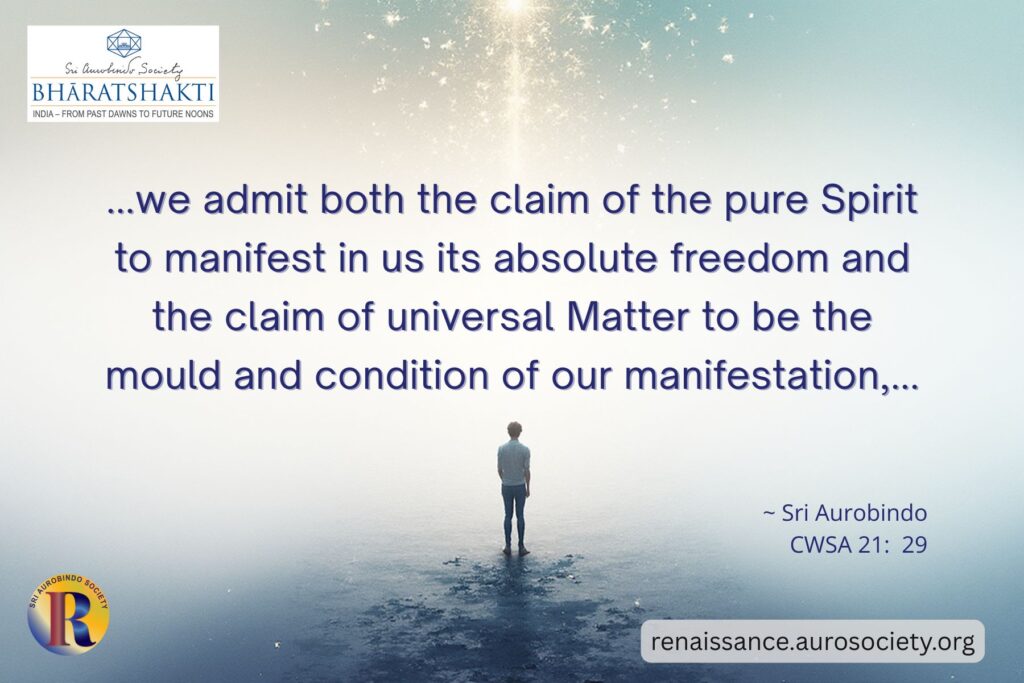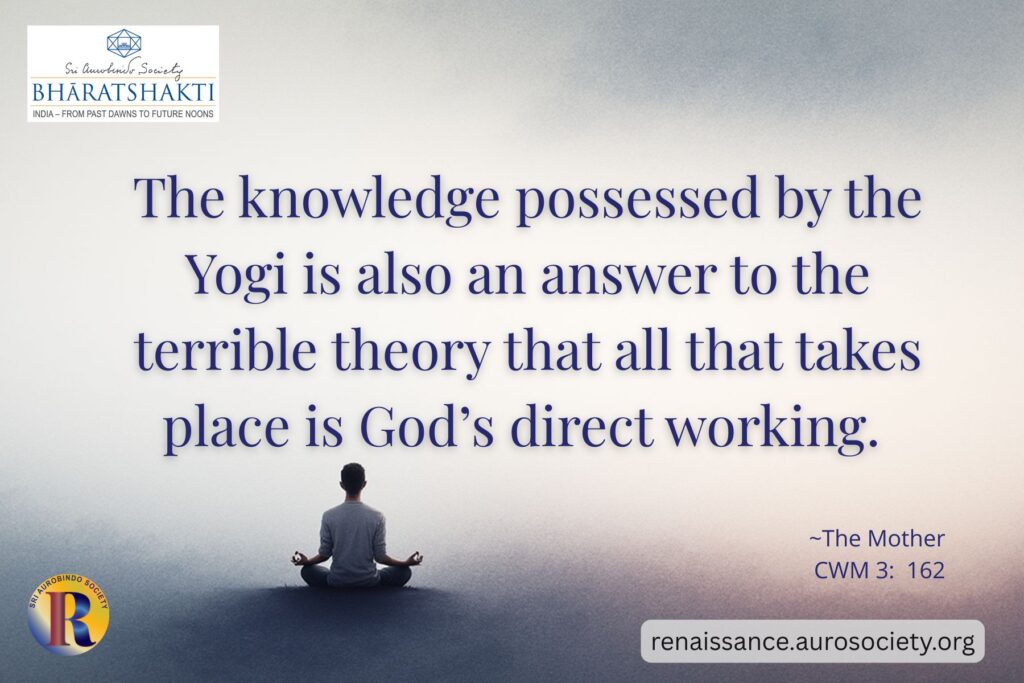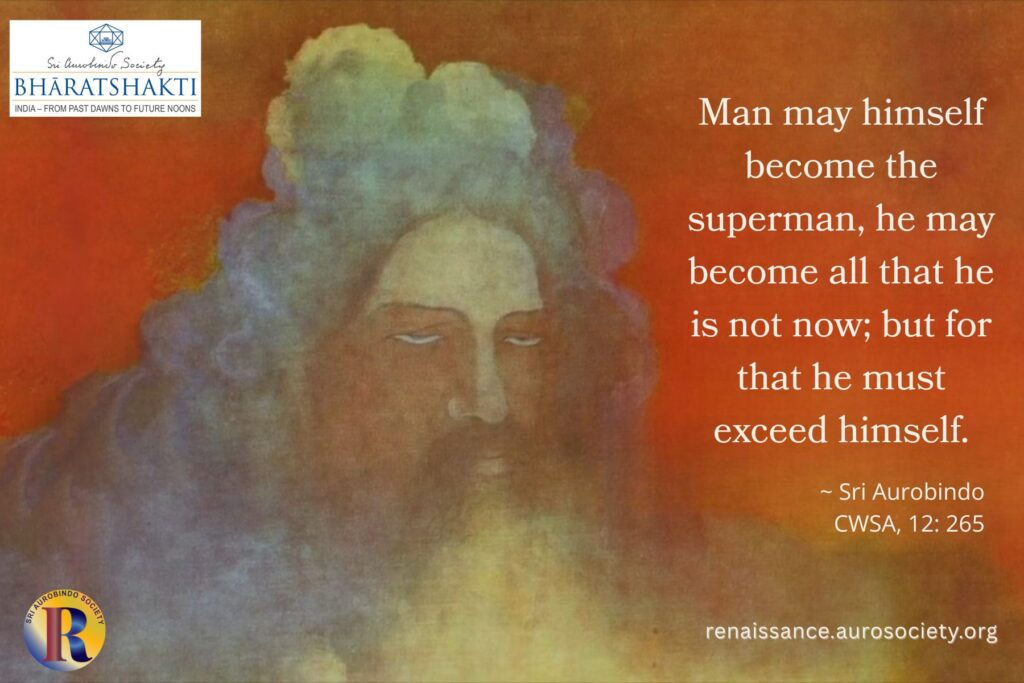Volume V, Issue 8
Author: Georges van Vrekhem
Continued from Part 2
Editor’s Note: In Part 3, the author zooms in on the avatarhood of Sri Aurobindo, with a focus on the double nature of his avataric work – to bring down the Supermind as well as to wage a war against the hostile forces.

3. Sri Aurobindo: Avatar
The avatarhood of Sri Aurobindo has been put in doubt on several occasions. There seem to be two reasons for this, the first being that the claim to avatarhood by pseudo-spiritual persons has indeed become very cheap. As the discernment between spirituality, guruship and occult powers is generally vague among those who search for solace or spiritual theatrics, the word “avatar” has, and justly so, become suspect among the sceptically-minded.
The second reason, especially among Westerners, is that the word “Avatar” is put on a par with the word “God”, and that this “God” is still commonly seen as the bearded autocrat in nightdress above the clouds or seated on a throne in heaven.
Did Sri Aurobindo never say himself that he was an Avatar? An outright affirmation would, in the first place, have been contradictory with his delicate, tactful character. In the second place, Avatars in general do not seem to proclaim their avatarhood.
“Why should the Avatar proclaim himself except on rare occasions to an Arjuna or to a few bhaktas or disciples? It is for others to find out what he is; though he does not deny when others speak of him as That, he is not always saying and perhaps never may say or only in moments like that of the Gita, ‘I am He’.”
~ Sri Aurobindo, CWSA, Vol. 28, p. 496
Besides, the persons who have any specific idea about the mission of the Avatar and the world-crisis in which he incarnates, are rare exceptions. This may be is the reason why Sri Aurobindo wrote that the Avatars were generally recognized as such only by a few, while to the others they were quite human, even though perhaps extraordinary, persons. “It is a question between the Divine and myself – whether it is the Divine Will or not, whether I am sent to bring that down or open the way for its descent or at least make it more possible or not,” wrote Sri Aurobindo.
“Let all men jeer at me if they will or all Hell fall upon me if it will for my presumption – I go on till I conquer or perish. This is the spirit in which I seek the Supermind, not hunting for greatness for myself or others.”
~ CWSA, Vol. 35, p. 282
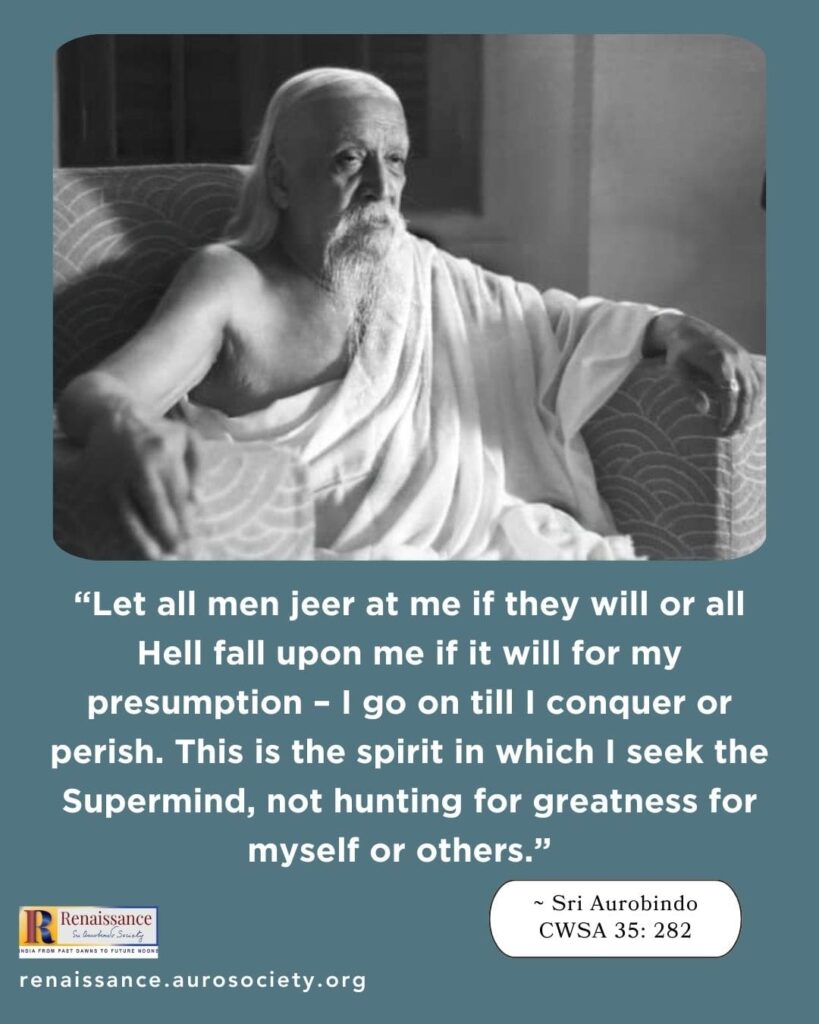
When a disciple wrote to him: “I have a strong faith that you are the Divine incarnation. Am I right?” Sri Aurobindo answered: “Follow your faith – it is not likely to mislead you.”
Surely, Sri Aurobindo has declared many times that he was an Avatar, not in plain words but in ways which can leave no doubt about the meaning of his statements. A few examples will have to do. “I have said ‘Follow my path, the way I have discovered for you through my own efforts and example. … I have opened the way, now you with the Divine help can follow it.’ ” What kind of way or path did he mean? It was “… the path I opened, as Christ, Krishna, Buddha, Chaitanya, etc., opened theirs.”
“My experience is the centre and condition of all the rest,” by which he meant the supramental realization on Earth.
“If I am seeking after supramentalization, it is because it is a thing that has to be done for the earth-consciousness and if it is not done in myself, it cannot be done in others. My supramentalization is only the key for opening the gates of the supramental to the earth-consciousness; done for its own sake, it would be perfectly futile.”
~ ibid., p. 283
Nagin Doshi, at the time a young disciple, wrote to Sri Aurobindo: “We believe that you and the Mother are Avatars. But is it only in this life that both of you have shown your divinity? It is said that both you and she have been on the earth constantly since its creation. What were you doing during the previous lives?” Sri Aurobindo’s answer, laconic but so full of meaning: “Carrying on the evolution.” (CWSA, Vol. 32, p. 88)
These words bring to mind what he wrote about Sri Krishna:
“As for the lives in between the Avatar lives, it must be remembered that Krishna speaks of many lives in the past, not only a few supreme ones, and secondly that while he speaks of himself as the Divine, in one passage he describes himself as a Vibhuti, vṛṣṇīnāṁ vāsudevaḥ. We may therefore fairly assume that in many lives he manifested as the Vibhuti veiling the fuller Divine Consciousness.
“If we admit that the object of Avatarhood is to lead the evolution, this is quite reasonable, the Divine appearing as Avatar in the great transitional stages and as Vibhutis to aid the lesser transitions.”
~ CWSA, Vol 28, p. 487
“The Mother’s consciousness and mine are the same,” wrote Sri Aurobindo, “the one Divine Consciousness in two, because that is necessary for the play.” He wrote “Divine Consciousness” with capital letters. And there is for example the following statement of which we cannot even sound the depth: “It is only divine Love which can bear the burden I have to bear, that all have to bear who have sacrificed everything else to the one aim of uplifting earth out of its darkness towards the Divine.”
In the last years of the Entretiens (Questions and Answers), the Mother explained the significance of Sri Aurobindo’s birth on the various levels of existence. Physically, she said, the consequences of his birth will last as long as the Earth; mentally, it is a birth the memory of which will last eternally; psychically, it is a birth which will recur eternally, from age to age, in the history of the universe; spiritually, it is the birth of the Eternal on Earth.
Sri Aurobindo Warrior
Usually the Avatars seem to be contemporaneous with great, world-changing wars in which they play a crucial role. This is easily understandable if one remembers that the intervention of the Avatar is needed at a time of world crisis – “a crisis in the consciousness of humanity when it has to undergo some grand modification and effect some new development” – and that, under the conditions of the evolution up to now, such a kind of crisis generally expresses itself physically in conflicts which we call war.
In Essays on the Gita, Sri Aurobindo wrote:
“Vishnu, incarnated as Krishna, delivered the oppressed Pandavas and destroyed the unjust Kauravas. A similar account is given of the descent of the previous Vishnu Avatars, of Rama to destroy the unrighteous oppression of Ravana, of Parashurama to destroy the unrighteous license of the military and princely caste, the Kshatriyas, of the dwarf Vamana to destroy the rule of the Titan Bali.
“But obviously the purely practical, ethical or social and political mission of the Avatar which is thus thrown in popular and mythical form, does not give a right account of the phenomenon of Avatarhood. It does not cover the spiritual sense, and if this outward utility were all, we should have to exclude Buddha and Christ whose mission was not at all to destroy evil-doers and deliver the good, but to bring to all men a new spiritual message and a new law of divine growth and spiritual realisation. …
“Always we see in the history of the divine incarnations the double work, and inevitably, because the Avatar takes up the workings of God in human life, the way of the divine Will and Wisdom in the world, and that always fulfils itself externally as well as internally, by inner progress in the soul and by an outer change in the life…
“The Avatar may descend as a great spiritual teacher and saviour, the Christ, the Buddha, but always his work leads, after he has finished his earthly manifestation, to a profound and powerful change not only in the ethical, but in the social and outward life and ideals of the race.”
~ CWSA, Vol. 19, p. 170
Even the mission of Christ, the “Prince of Peace”, has led to a superabundance of internal and quite physical struggles in Christianity, and to the Crusades and the Wars of Religion. Christ’s own words as quoted in the gospel of Matthew should not be forgotten: “Do not suppose that I have come to bring peace to the earth. I did not come to bring peace, but a sword. For I have come to turn a man against his father, a daughter against her mother, a daughter-in-law against her mother-in-law. A man’s enemies will be the members of his own household.” (Matth. 10: 34-36)
Sri Aurobindo is generally seen as in the photos of Henri Cartier-Bresson: the old wise man seated unmoved and unmovably in his big chair, Nirodbaran’s “Golden Purusha”. But if this is the sole aspect of Sri Aurobindo, or the sole one taken into consideration by so many of his perhaps “too ethereally-minded” disciples, when or where did he do the avataric work about which he wrote, for instance, in his correspondence with Nirodbaran, in his letters, poems and Savitri? When and where did he wage his battles against the assailing Titan kings?
It is obviously a distortion to see Sri Aurobindo only as the inexhaustible source of Love and Peace, which he was and is for anyone turning towards him, and not as the great warrior who had to fight, together with the Mother, the decisive battles for the new world. Of these battles the three 20th century wars – the First and Second World War and the so-called Cold War (actually one war in three parts) – were partial externalizations.
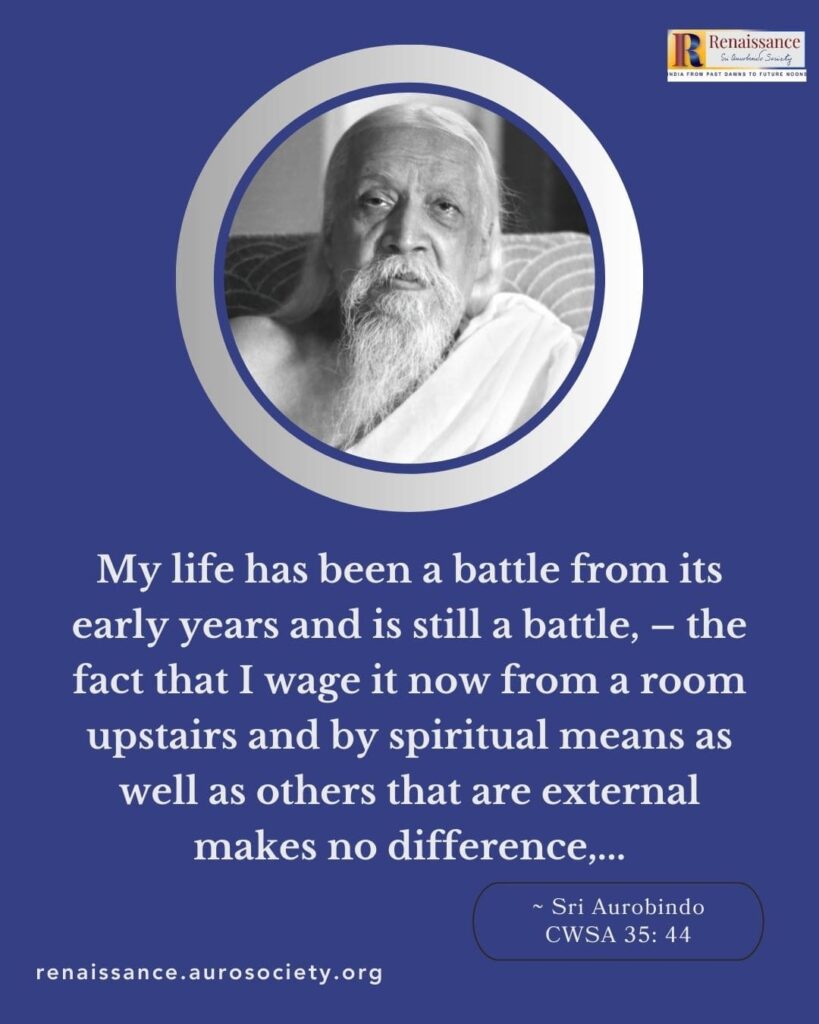
“My life has been a battle from its early years and is still a battle, — the fact that I wage it now from a room upstairs and by spiritual means as well as others that are external makes no difference,” wrote Sri Aurobindo in the middle of the 1930s, when dark clouds gathered over the world and he himself was soon to be attacked in his physical person.
... Each enemy slain revives,
Each battle for ever is fought and refought
Through vistas of fruitless lives.
My gaping wounds are a thousand and one
And the Titan kings assail,
But I cannot rest till my task is done
And wrought the eternal will.
~ Sri Aurobindo, A God's Labour, CWSA, Vol. 2, p. 535
In Savitri, his spiritual autobiography and testament, we find reports of his avataric battles on many pages, such as:
But though to the outward eye no sign appears
~ Savitri, CWSA, Vol. 34, p. 446
And peace is given to our torn human hearts,
The struggle is there and paid the unseen price;
The fire, the strife, the wrestle are within.…
A million wounds gape in his secret heart.…
Antagonist forces crowd across his path;
A siege, a combat is his inner life.…
His large identity and all-harbouring love
Shall bring the cosmic anguish into his depths…
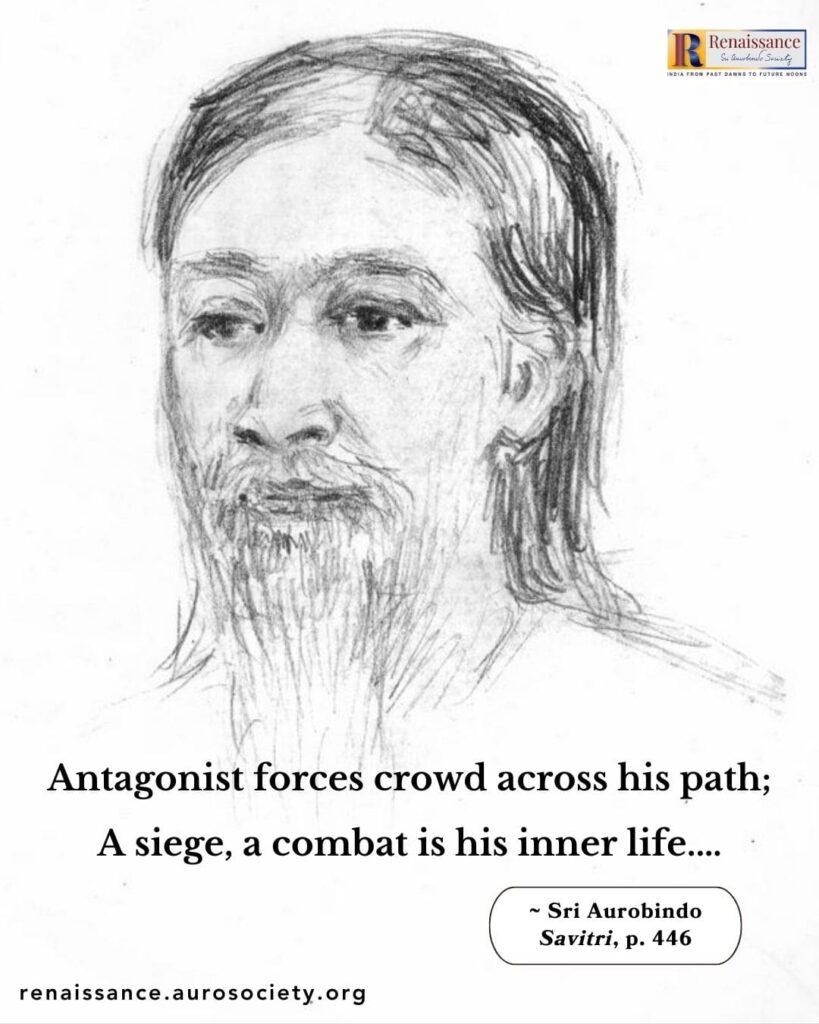
CONTINUED IN PART 4
~ Design: Beloo Mehra

